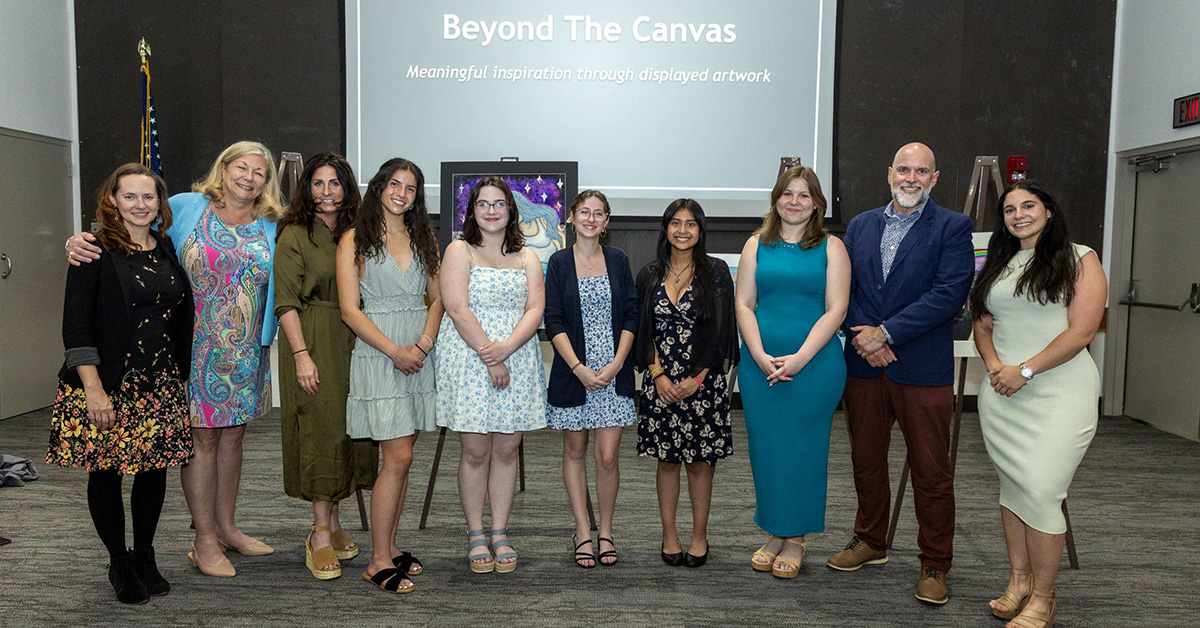
As a designated “muse,” Fox Chase Cancer Center’s Hossein Borghaei, DO, MS, was not sure what to expect from Mary Korol, the William Tennent High School senior who interviewed him as the subject for her contribution to the annual Beyond the Canvas program. He could not necessarily fathom what exactly she took away from their conversation or how that would be presented in a painting.
While Borghaei could not step away from work to see the unveiling, held this summer in the cancer center’s Leidy Auditorium, he was able to view the work after the presentation. The results surprised him.
“I am amazed, humbled, and overtaken by many emotions that are hard to articulate,” Borghaei said. “Mary is wise beyond her age; she is very perceptive and picked up on the more emotional and cultural aspects of what I do.”
Going Beyond Your Typical AP Art Class
Now in its sixth year, Beyond the Canvas began as an idea generated through an ongoing partnership between William Tennent’s Student Design Lab and Fox Chase’s Office of Academic Affairs.
The Student Design Lab was developed by William Tennent science teacher, Ignacio Jayo, who sought to provide a learning experience that more closely resembled the complex world in which his students would ultimately find themselves. The lab is a full-credit, year-long class that Jayo co-leads with art teacher Rena Friedant. The class is designed to present real-world challenges to students and encourage them to come up with their own solutions.
Beyond the Canvas arose in 2019 as Tennent students toured the cancer center while exploring possible topics for the Student Design Lab. One student, in particular, then-high school junior Sophia Trozzi, noticed that there was a disconnection between the clinical setting of the facility and the palpably emotional culture of its staff, patients, and volunteers. She pitched the idea and has been an active participant in the program ever since.
Jayo brought the concept to Glenn Rall, PhD, Fox Chase’s Chief Academic Officer, and Amanda Purdy, PhD, Associate Chief Academic Officer, who immediately saw the potential. In fact, Beyond the Canvas came about after visiting Tennent and brainstorming ways of connecting the patient experience to the artwork in the halls of the cancer center.
“It tickles me that I get to be involved in this program that, at first glance, doesn’t necessarily have anything to do with research,” remarked Purdy at the 2024 Beyond the Canvas unveiling, “but if you look a little closer it does, because research, as a field of work, is all about connections with people collaborating to innovate something new.”
The Beyond the Canvas challenge is open to seniors enrolled in the school’s Advanced Placement Studio Art class. Friedant begins recruiting artists in January and the training process goes through to May when they finally interview their muses – people from the Fox Chase community who have been recruited to participate with the guidance of people like Helen Gordon, Director of Volunteer Services. The artists then have three weeks to produce a work of art.
As co-chair of the Fox Chase art committee, Gordon can attest to the effect the partnership with William Tennent High School has had on patients and their families.
“Each year, I anticipate the awe that I feel when I hear from students and then the impact it has on the muses,” said Gordon. “This program leaves a legacy of empathy, supporting the healing and recovery of our patients.”
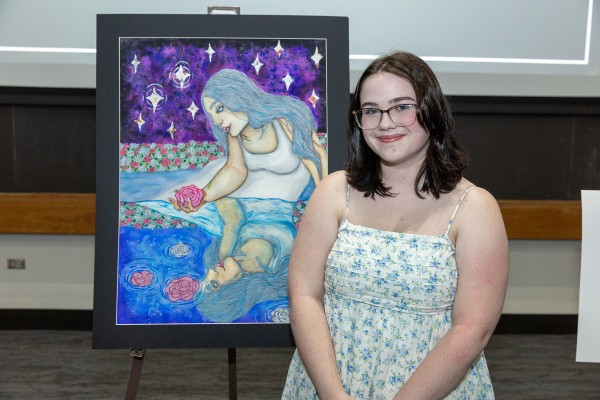
A Reflection of the Soul
Lily Boyce, Artist
Joann Bono, Muse
As the COVID pandemic hit, Joann Bono retired from teaching and joined her partner on an epic road trip to see the sights and visit friends and family. Life on the road, however, was curtailed by multiple cancer diagnoses at once. Bono was treated at Fox Chase for lung, breast, and bile duct cancers, and has remained an advocate for the Women’s Cancer Center.
If creating a piece for an art teacher intimidated Lily Boyce, it did not show.
“Creating art has been a coping skill and passion of mine, but meeting Joann was a profound experience,” said Boyce. “It takes a rare and special connection to create something for someone who will care about and understand what you mean.”
A Reflection of the Soul represents the sense of peace and vitality Bono inspired in Boyce. The young woman reclining by the water represents Bono’s youthful yet retrospective spirit. The flowers represent the cancers she has experienced – white for lung, pink for breast, and green for bile duct, while the paint on the hands of the figure represents Bono as an artist and force of creativity.
The painting honors Bono’s favorite media: collage and watercolors. The twelve paper stars surrounding the figure represent her family – the two large stars symbolize her twins, while the ten smaller ones are her grandchildren.
“As a former art teacher, I can’t imagine a bigger honor than a piece of artwork in a place I love,” explained Bono.
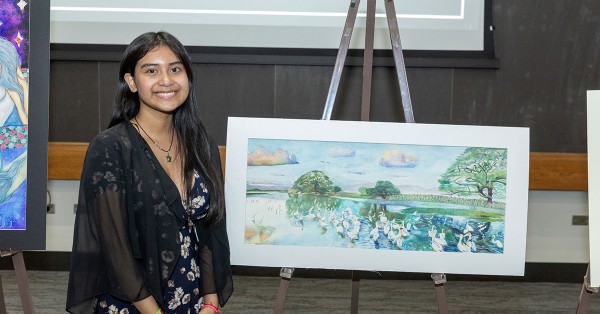
Quiet Sanctuary
Michelle Ortiz, Artist
Leah Powers, Muse
Like A Reflection of the Soul, Michelle Ortiz’s Quiet Sanctuary touches on themes of peace and tranquility, with water as a motif. It also is laden with symbolism that she pulled from her interaction with her muse, Leah Powers, a health educator in Fox Chase’s Lippincott Resource and Education Center.
“Art is a language that takes time to learn – you don’t use words, but colors and meaning,” said Ortiz. “Ms. Powers advocates for others and she wants people to make sure they aren’t alone in their journey.”
Quiet Sanctuary is a landscape that, according to Ortiz, symbolizes the entire ecosystem of connections that comprise the Fox Chase experience. The landscape, like the staff, feels warm and connecting (although the physical space depicted was inspired by the Ortiz family’s hometown in El Salvador). The flowers on the bank symbolize the personality of Powers: goldenrod symbolizes her protection and tenacity, while dahlias symbolize her compassion.
The pelicans represent all the people she has connected with and helped, while the water represents the peace and tranquility that Powers provides. The pair of birds in the background represents her parents, watching over her in the distance.
At the unveiling, it was apparent that the inclusion of her parents particularly touched Powers, since she was a caregiver for them when they each faced cancer. “I didn’t realize she was paying so much attention to me,” Powers said about Ortiz. “For you to remember my mom and dad…”
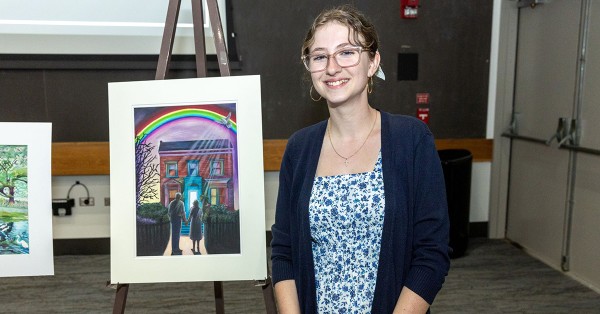
Eternal Covenant
Gisella Fatzinger, Artist
Brian Dooley, Muse
According to Gisella Fatzinger, her muse, Brian Dooley, shared a remarkable story that formed the basis of her painting. Dooley is the caregiver for his wife, Cynthia, who has stage four cancer, and told of how he relied on his faith throughout the harrowing experience of her diagnosis and therapy.
He told Fatzinger of how, when they first saw the house that would become their home, a rainbow appeared in the sky directly above it. He described his love for Cynthia and how he would refer to her treatment appointments as “date days.” On the way home from one such date day at Fox Chase, their path followed a rainbow in the sky that ended right over their home. To Dooley, it was a sign of God’s promise to reward faith and hope in the darkest of times.
Eternal Covenant depicts a couple standing hand-in-hand before a house crowned with a rainbow. The house is bright and colorful, as if staving off the darkness surrounding it. A dove, naturally, symbolizes the presence of God.
“I’ve only become comfortable with being uncomfortable this year,” said Fatzinger. “I’ve pushed past my own reluctance to embrace my talents, and I believe that’s part of the transformative power of art.”
Dooley admits he was unsure how he would ultimately be depicted, but expressed his appreciation for Fatzinger’s work. “I would just say pray,” Dooley stated, “not just for us but for every patient, survivor, and caregiver.”
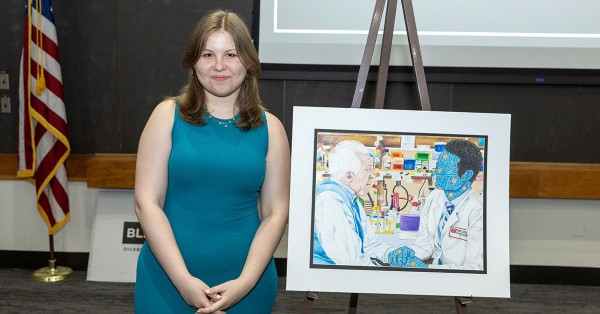
Tawāżo
Mary Korol, Artist
Hossein Borghaei, Muse
The title Tawāżo comes from the Farsi word for humility, which forms the basis of Mary Korol’s impression of her muse, Hossein Borghaei, who was the first physician to serve as a muse in the program’s history. The image depicts Borghaei as a luminous blue figure, embracing the hand of a patient in the act of breaking news that they had run out of clinical options.
According to Korol, she was struck by Borghaei’s description of how patients frequently react to such news “with gratitude and a handshake versus anger and resentment.” Korol says she could not help but marvel in appreciation of how someone as determined and tenacious as Borghaei can also face such challenges as delivering a poor prognosis with such humanity and humility.
Korol says her experiences in understanding the cultural differences in her life as a Russian-American provided a framework for how she would paint Borghaei. The figure representing Borghaei is covered with sacred Iranian ornamentation on its face and hands, which she says honors his work and family background.
“I attempt to depict his cultural heritage and the humility that allows him not to accept anything less than his best,” she said. “I was deeply honored to tell his story through a medium that gave me a voice – art.”
While he missed the unveiling, Borghaei had the opportunity to view all of the Beyond the Canvas entries. He says that art provides a way to “translate” the experiences of patients, families, and medical professionals into something more broadly understandable for the wider world.
“It is difficult to explain how one feels when going through a hard experience,” Borghaei noted. “I think the artists in this program have been able to interpret these varied experiences into art pieces that depict stories often hidden.”